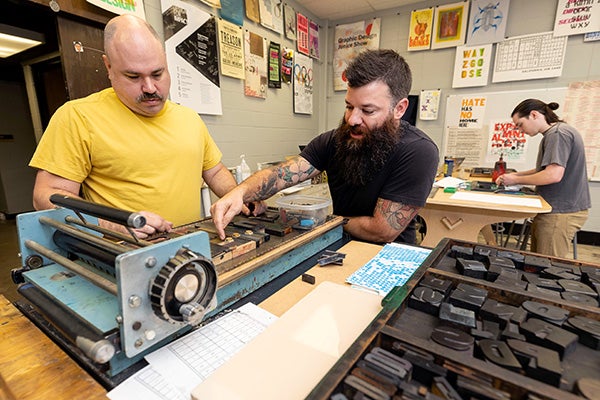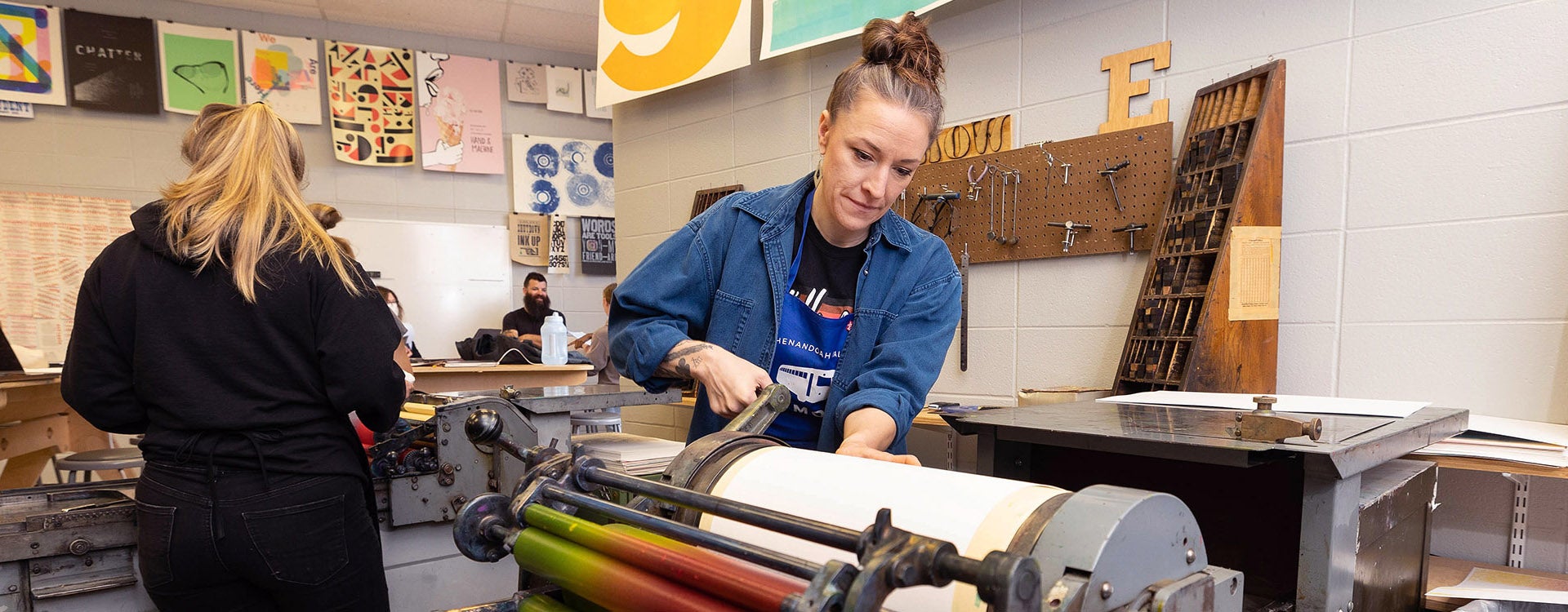THINK INK
Summer class mixes letterpress printing with problem-solving
Students are mixing ink with problem-solving and critical thinking skills in an experimental letterpress print class at East Carolina University this summer.
Everything from bubble wrap, chipboard and mylar to traditional wood and metal-cast type is being used for letterpress printing, a centuries-old art form. Also called relief printing, the process involves producing an image using an inked, raised surface that is pressed and transferred to make multiple copies.
“They are doing things that they don’t know how to do, and learning through the process of doing it, so there’s a lot of failure and figuring out why it didn’t work,” said Dan Elliott, associate professor of graphic design, who gives his students a weekly prompt with a new process or technique — along with freedom to investigate what they can create.
“It’s more of a critical thinking class than it is about making any specific thing and figuring out how to control the outcomes to get the same thing repeatedly. That’s where the problem-solving comes in. Because it might be something by accident. Then, OK, how do I make that on purpose, and make it consistent?” Elliott said.

Dan Elliott, right, associate professor of graphic design, talks with graduate student Michael Gaines about his art piece.
At the end of the five-week class, hundreds of prints up to 12 by 20 inches in size will be connected and hung from the ceiling in the two-story Jenkins Fine Arts Center lobby. “All the processes and techniques that they’re learning now will apply to the final project,” Elliott said.
The class has 11 students, with a mix of undergraduate and graduate majors ranging from art education and illustration to photography and graphic design, where most of their use of color is digital.
“When they’re mixing color here, they learn more about how color works. So even if they’re struggling to get an exact color when they go back to the computer, they know a little bit more about what they’re selecting, which is nice,” Elliott said.
Some are combining multiple interests, including one student majoring in art with concentrations in graphic design and photography who was printing on darkroom paper. “He’s combining letterpress printing with photography in ways that you wouldn’t expect. He’s not printing a photograph, he’s printing on photo paper and seeing what the outcomes are, which has led to cool results so far,” Elliott said.
Michael Gaines, a graduate student from Charlotte studying photography, also likes mixing different forms of media together. “I love alternative photographic processes, so any way that I can incorporate that into different projects. I also like to work in book arts,” Gaines said. “A class like this really helps you think outside the proverbial box so that’s why I really wanted to take it to push my ways of thinking.”
Last week, Gaines made a piece called “tiny bubbles” on paper he printed the previous day with bubble wrap. He used different letter and text-based type — two exclamation marks and an apostrophe for a fishing line, two letters to make a fish, another from a Russian letter — in his final product.
ECU’s School of Art and Design has about 500 cases of metal type and three cases of wood type arranged neatly in tall cabinets beside letterpresses and production tables. Past print projects hang along the classroom’s perimeter, along with variations of the numbers nine, one and eight — a significant number in the letterpress community because type is .918 inches tall, Elliott said.
Anna Query of Raleigh, a rising senior studying film and graphic design, said she wanted to take the class for her portfolio and to work outside of a predominantly digital space. “It’s something different because we’re mainly on the computer all the time. It changes it up,” she said. “You can come up with so many different ideas, and I feel like every day is a new idea.”
Lexi Karaivanova, a rising sophomore and political science student from Greenville, said she was looking forward to thinking more creatively since she’s not an art major. “I can’t have an idea in my head and then know how it’s going to translate, so being able to be more in tune with that,” she said. “Getting out of the box, not taking things as seriously. I’m doing something I don’t know how to do, and every day is different.”
Rachel Spencer, a junior art education major from Wilmington, plans to teach art following graduation and wants to learn as many methods as possible for her students. “This is probably the most interesting class ever,” said Spencer, who was collaborating with Jalisha Armstrong, a rising senior from Tarboro studying illustration.
In addition to different type forms, students have been experimenting with ink, including adding mineral spirits to the surface of the form to see what happens.
“This is knowledge acquisition and not about what the final piece will look like,” Elliott said.
“The way I look at my experimental work is that it informs my professional work. It’s something I can do and mess up without fear of my client being upset that I’m taking too long. If I have those processes in my tool bag, I can do something for a client or a commission and I don’t have to experiment then, I just know how to do it. A lot of it is learning how to go through that process, learning how to control it, and then they know how to do it later when maybe there’s a higher risk for failure.”

Emily Hall uses a letterpress in a summer class in Jenkins Fine Arts Center.
